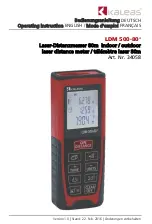
Monochromated X-Ray Source with XR5 Electron Gun
Issue 5
Monochromator and XR5 (HA600054)
11
To focus the X-rays from the source to a spot on the sample, the two quartz crystals
must be formed to the correct geometry. This not only provides point to point focusing
by mirror reflection but also maintains a constant angle of diffraction at the surface,
which corresponds to the Bragg angle.
Figure 3-4: A Schematic of Bragg X-Ray Diffraction
The Bragg angle is critical to the monochromator performance and is related to the
crystal lattice spacing and the wavelength of incident X-rays. Only X-rays of a certain
wavelength incident to the crystal lattice structure at a specific angle will be reflected to
the correct point; this angle is the Bragg angle.
The ESCALAB 250 uses an apertured toroidal geometry on a 500 mm Rowland Circle
to give the highest possible energy resolution. Each crystal substrate is machined to
the exact form required and a thin single-crystal quartz wafer is then bonded to its
surface.
This crystal assembly is then mounted in a precision mechanism as shown in Figure
3.3. This assembly allows the orientation of the crystal to be set precisely, using two
sets of three external micrometers without venting the system.
The lower leg assembly provides an additional adjustment. This adjustment enables
the “Bragg” angle between the anode and both crystals to be optimised; it is frequently
referred to as the 'Leg Angle' as shown in Figure 3.5.
Figure 3.5: Leg Angle Adjustment
Monochromated X-Ray Source with XR5 Electron Gun
Monochromator and XR5 (HA600054)
Issue 5
12
3.5
Moving the XR5 Anode
If degradation of the aluminium anode does occur a new area of anode can be
selected by moving the anode with the linear transfer drive mechanism until a
satisfactory signal level is restored. The XR5 monochromator has been specifically
designed so that the anode can be safely moved while the monochromator source is
running.
The performance of the anode is most effectively checked by measuring the sensitivity
for the Ag3d
5/2
XPS line on a sputter-cleaned standard silver sample in standard
analyser modes. However when adjusting the anode position observation of either the
spot on a phosphor sample or any high level XPS signal should suffice as a monitor.
The linear motion drive moves the anode by 0.8 mm per turn. The range of motion and
the useful anode length are both 25 mm. A fraction of a turn (for example a half turn)
will usually be enough to expose a new aluminium film area.
3.6
Monochromator Fine Tuning
Complete alignment and set up of standard operating conditions will generally be
carried out by Thermo Fisher Scientific service engineers and most operators will not
need to be concerned with any significant monochromator alignment. However
monochromator fine-tuning is a procedure that both engineers and operators need to
be familiar with.
In order to maintain optimum performance of the ESCALAB 250 the instrument
operator should check that the anode surface is in good condition on a daily basis, and
renew this surface as described in the previous section. The operator should also
regularly check (a minimum of once a week) that the analysis position (as defined by
the microscope cross hairs and/or XP imaging) coincides with the true position of the
X-ray beam on the sample.
For these simple alignment checks it is essential to have a phosphor sample (such as
Thermo Scientific Part No. SK1066-004) mounted on a sample holder, together with a
piece of silver, or silver on silicon, and a TEM grid sample mounted over a hole. It is
usually convenient to leave such a sample set-up mounted permanently on a sample
block, and to leave it in the bottom of the FEAL when not required so that it remains
free from contamination.
3.6.1
Alignment of the Analysis Centre and Microscope Cross Hairs
Minor misalignments (<200
P
m) of the microscope cross hairs and monochromator
can develop over time. These can quickly be corrected without significantly affecting
the instrument performance.
Before making any adjustments to the monochromator ensure that the monochromator
has had sufficient time to ‘warm up’, typically at least one hour. Frequently apparent
minor misalignments of the monochromator spots are due to insufficient time being
allowed for the gun to stabilise at the operating conditions.
1. Place a standard phosphor sample and a standard silver-on-silicon sample
side by side on a sample holder. For convenience fit spacers under the thinner
sample to make the sample heights equal. Ensure that the silver sample has a
good earth contact.
2. Introduce these samples to the system.
3. Move the phosphor sample to the analysis position and check that the
phosphor surface is in sharp focus on the microscope display monitor.
4. Start the mono source and set up a visible beam with the smallest spot size.

































